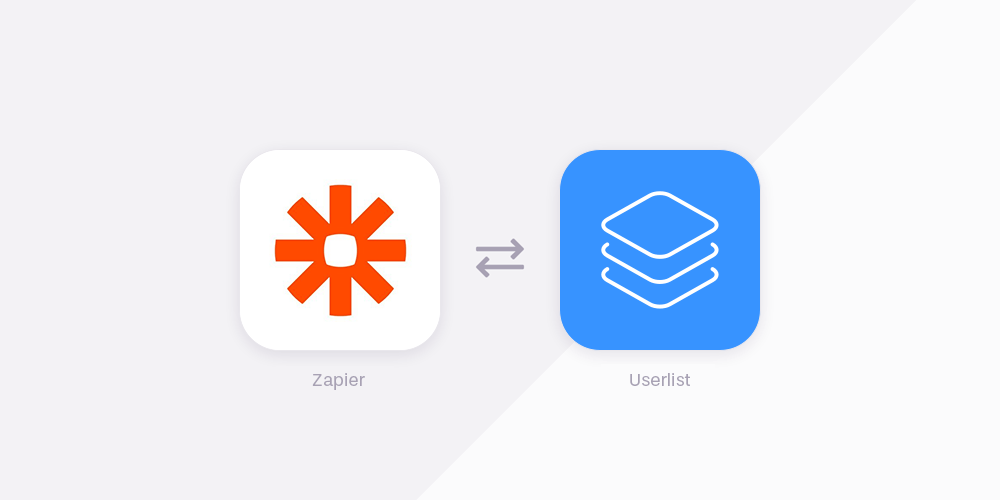Struggling to communicate with your user base? Wondering if segmentation will help you do it better?
At first glance, it would seem that all customers belong in the same big category. While they do have similarities among them, it’s naive to assume that all of them have the same needs, that they all come from the same backgrounds, and that it’s the same challenge that drove them to your product.
Your customers have many unique characteristics. They come from different companies, have different jobs and face various challenges. Customers don’t use your product in the same way.
Segmentation allows you to understand these differences in depth. Here’s what you’ll learn in this guide:
- What user segmentation is
- How to segment your SaaS customers
- Most common SaaS customer segmentation examples
Here and onwards, we’ll be using the terms users and customers interchangeably. Technically speaking, paying customers are a subset of your user base. In addition to paying customers, your users include trials, cancelled customers, and more.
Don’t wait for the muse. Apply this step-by-step method to write high-performing email campaigns in hours, not weeks.
What is user segmentation?
The term user segmentation refers to the practice of separating users into groups or segments based on various characteristics.
It’s by far one of the most common business practices done for a number of reasons. The most common one is to better understand your customer base.
Even simple segmentation can help you learn more details about the specific target markets such as:
- Their goals and needs
- Their personal details and background (age, education)
- The pain points that drove them to try out your product
- Their business or workplace (company size, industry, position)
Such details can make a big impact on how you approach your marketing down the road.
Segmenting accounts vs individual users
If you use account-level data (which we highly recommend), then you’ll inevitably face the segmentation dilemma. Both accounts and users can have segments of their own. Which ones should you use?
In a nutshell, most lifecycle segments exist on the account level.
We wrote a detailed guide on the topic, which has specific segment examples as well as general recommendations.
Why should you always start with segments?
If we could give one recommendation to a beginner email marketer, we would say: start with segments.
As we plan user onboarding and email automation for B2B SaaS, several steps are required:
- Develop the tracking plan (what data you need to collect, also called tracking schema)
- Bring that plan to your engineering team so that they can implement the integration
- Set up segments
- Set up automation campaigns
But it’s impossible to do it in this order: the waterfall approach doesn’t work. By the time you start setting up your segments, you will inevitably discover that you forgot an important property. And that means going back to your engineering team and begging them for more work.
What’s the solution to this chicken-and-egg problem?
Before anything, plan your lifecycle segments. They “connect” your customer data and email campaigns. If you get your segments right:
- You will know exactly what data you need to set them up. Your tracking plan won’t be bloated, but you won’t forget an important property either.
- You will have no problem setting up your campaigns. Most campaign triggers are as simple as “user joins a segment.”
- You will have no problem writing your campaigns. Each segment has its own conversion goal, so your campaigns need to focus on that one goal. E.g. trials should start receiving value from the product, and advanced customers should become your loyal advocates.
Why is it important to segment customers? The benefits of SaaS customer segmentation
We’re always amazed by the impact of segmentation on business communications.Take marketing automation, for example. Customer segmentation allows you to deliver the most relevant campaigns which can get you incredible results.
Take a look at this graph from Lyris Annual Email Optimizer:
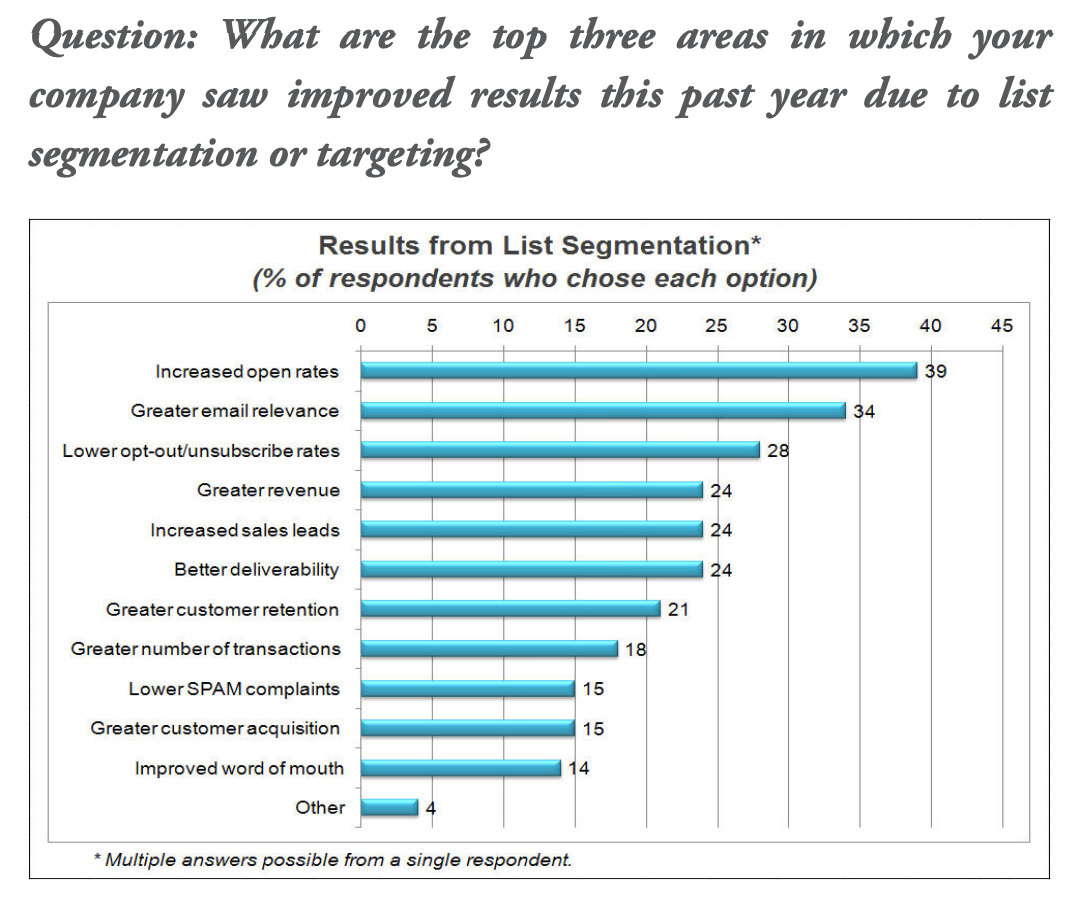
A study on email marketing by HubSpot also revealed that marketers who use segmented campaigns note as much as a 760% increase in revenue.
Segments simplify how you do marketing
Once you set up the segmentation criteria once, it’s there. You can use it in any marketing strategies or campaigns you run, which can dramatically increase your setup’s flexibility.
Segmentation improves your decision-making by allowing you to run better tests
This, in turn, can help you improve your product or service and learn how to engage your audience better.
Let us show you a quick example: you could test different pricing plans on different segments. Those findings could help you understand what options engage your customers better, and improve the pricing strategy.
Segmenting can help reveal your product-market fit
Shocking but true: a lack of product-market fit is the number one reason why SaaS startups fail.
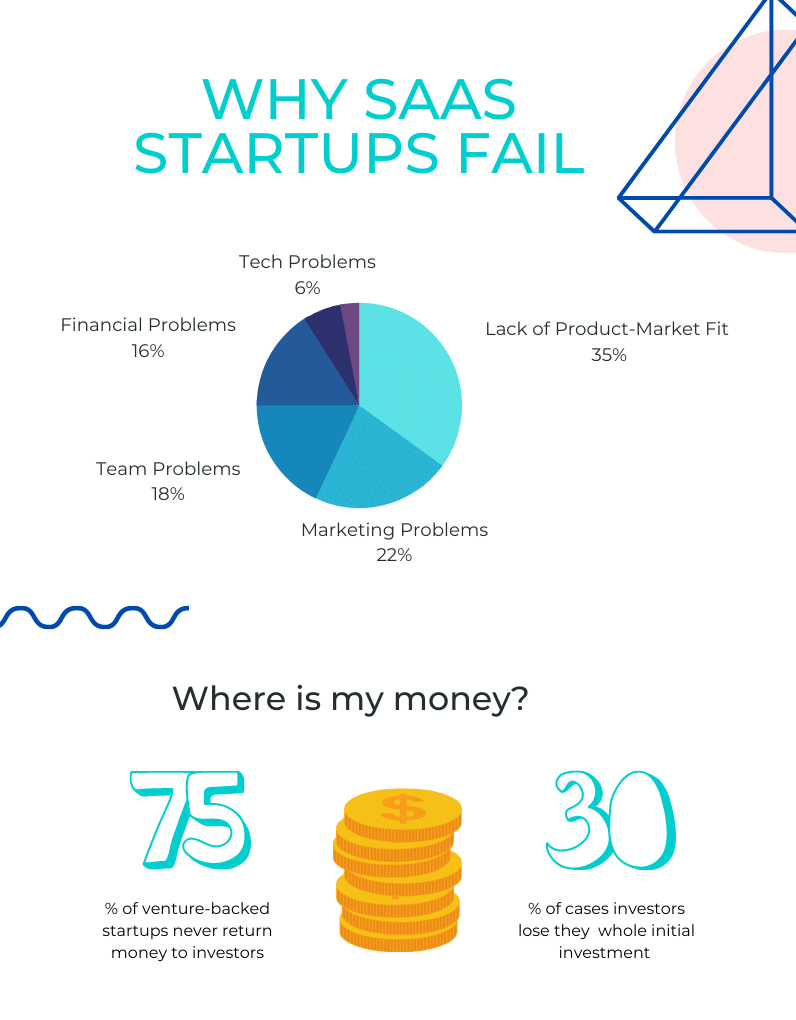
But what’s the one thing you need to nail the product-market fit? A buyer persona and segmentation allow you to create detailed personas of your customers.
Segmentation leads to a better customer experience
By understanding your core segments, you can deliver the right information to them on the website or the product dashboard and improve their experience.
Segmentation tells you whom to upsell. Your research might discover that certain customers tend to upgrade more often than others. And so, that’s a segment to target what upselling campaigns.
But how do you segment the customer base? There’s practically an unlimited number of ways to do so.
Don’t wait for the muse. Apply this step-by-step method to write high-performing email campaigns in hours, not weeks.
How to segment SaaS customers: 4 common approaches to a user segmentation strategy
#1. By customer lifecycle stages
Let’s face it: your customers engage with the product differently. Some have only discovered it. Others are experts, having been users for a long time.
Depending on their lifecycle stage, they’ll naturally have different needs, and your communications need to reflect that.
So segmenting the user base by lifecycle stages allows you to continue engaging them as the customer moves from one stage to another, from being only potential customers to becoming trial users, and finally paying customers, referrals, retention, and more.
Each lifecycle segment typically has its own “conversion goal” and a related email campaign that triggers when the user joins that segment. For example, the goal for Trials is to activate them. Usually this means increasing a specific activation metric from 0 to a certain number. When a user joins Trials, you send them a Basic Onboarding campaign which focuses on this goal.
Here’s a journey map that includes segments for a free trial model:
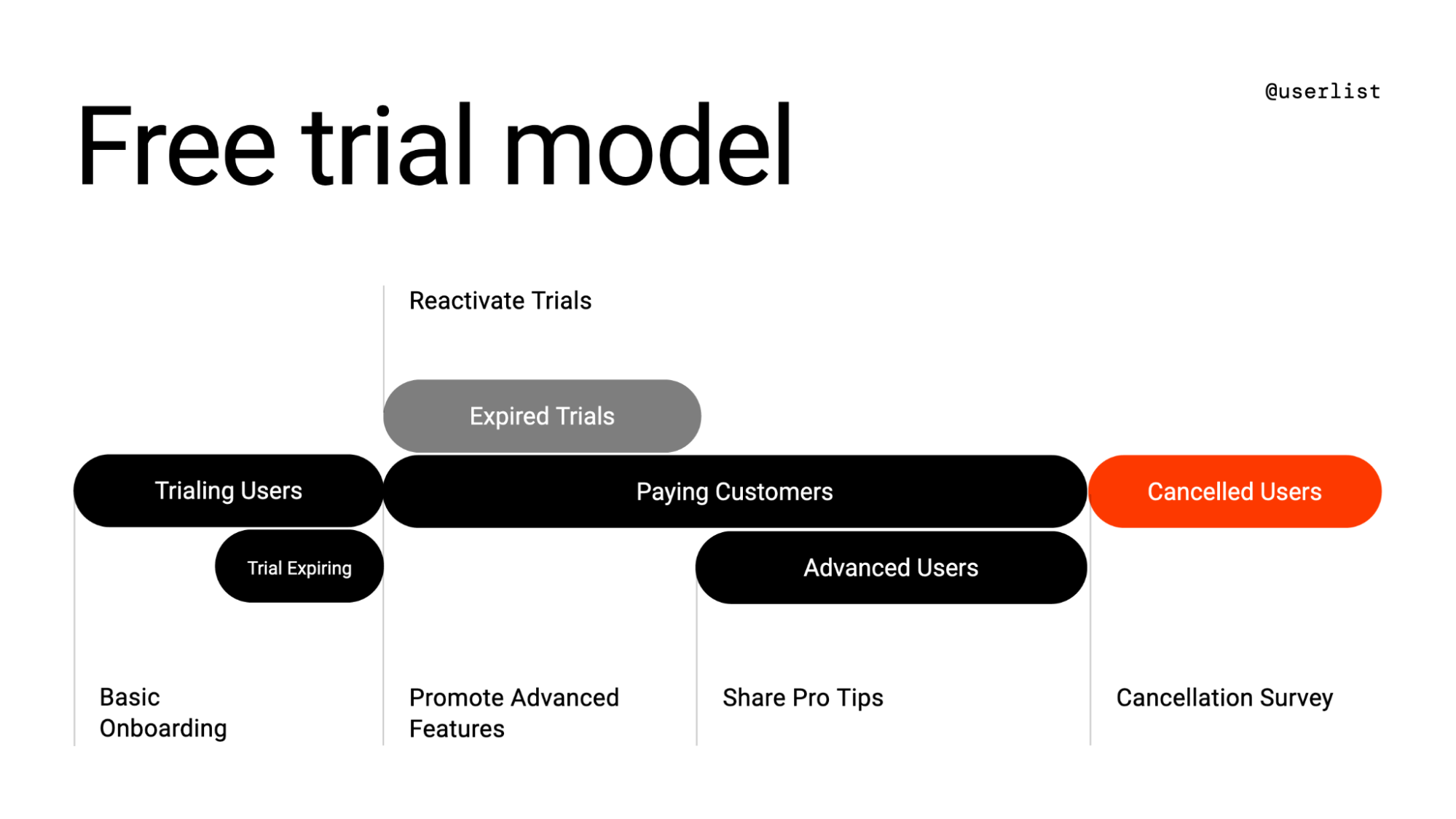
Here’s the same map, but for the freemium model:
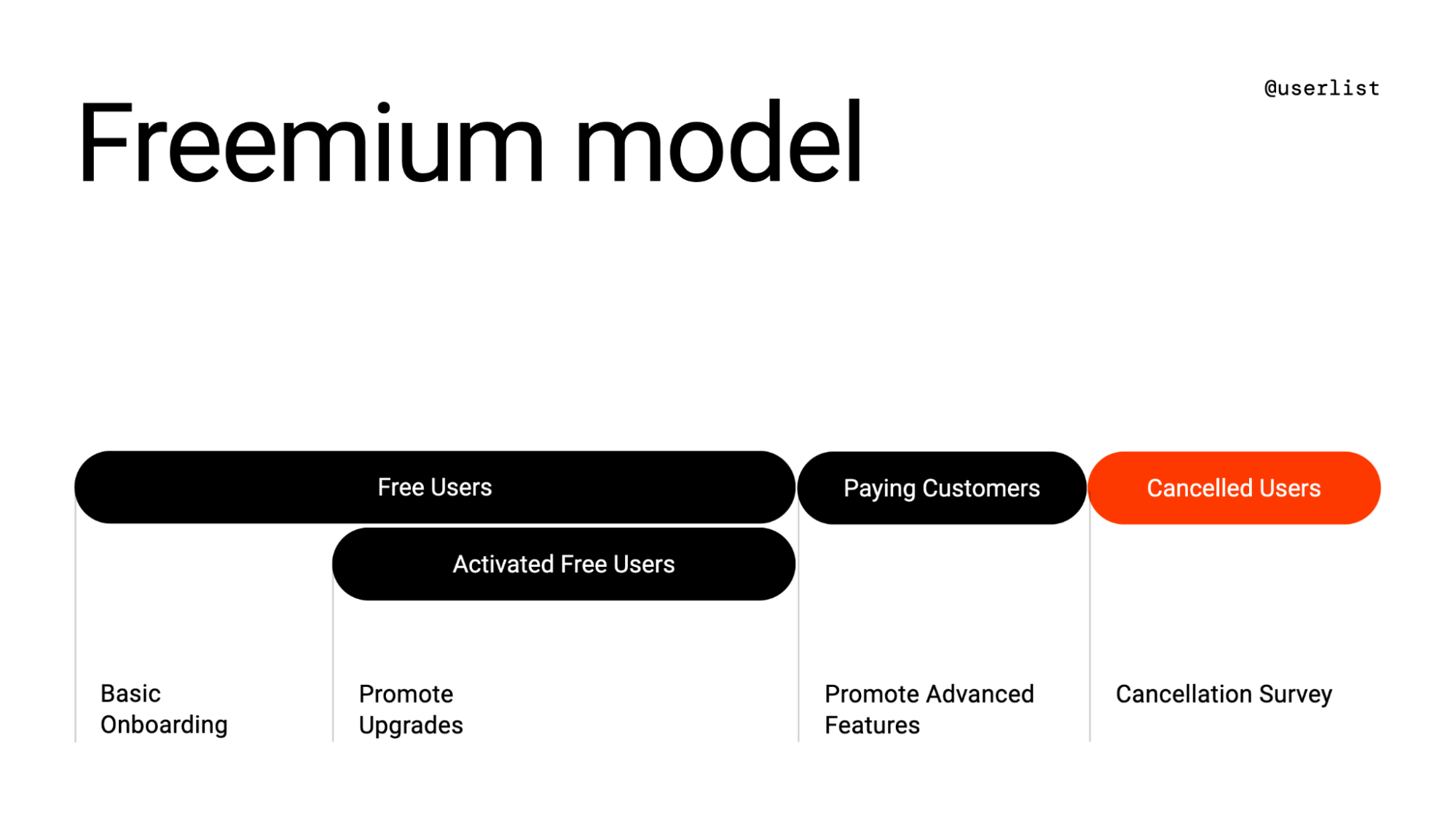
#2. By customer traits and characteristics
35% of SaaS companies fail because of a lack of a product-market fit. You overcome the issue by understanding why customers would need your product and developing buyer personas that match the best customers’ characteristics and allow you to steer anything from product development to marketing and sales.
Trait-based segmentation uses demographics, age, gender, work profile, and others, often in conjunction with other metrics, to understand customers’ pain points from who they are to why they’ve signed up.
#3. By product category
It’s easy to understand customer needs when you offer only a single solution. But what happens when you have more than one product? How do you know which one engages certain customers more?
Well, that’s what segmentation by product category helps you uncover.
In this case, you divide your customer base by different product categories and the corresponding user characteristics.
Take Microsoft, for example. The company owns over 100 different cloud products used by a mix of B2C and B2B clients. And sure enough, it uses product segmentation to understand the audience’s interest in their various offerings.
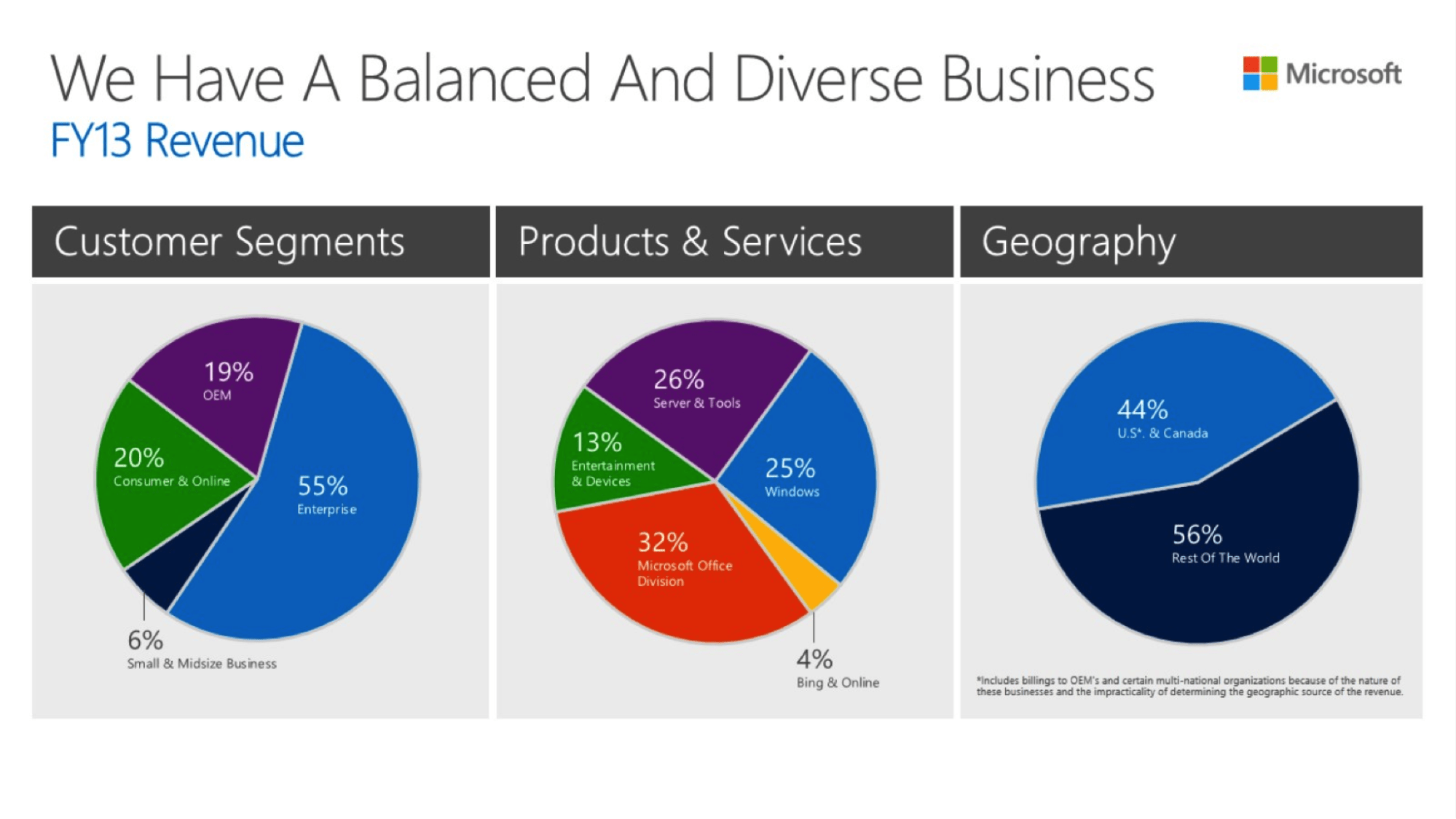
#4. By customer value
The most common approach to customer segmentation is doing it by customer value.
We remember this being one of the very first pieces of business advice we’ve ever received. A business mentor we worked with told us that the most important thing is understanding the numbers behind each customer.
Why? Because not all customers are worth the same to you. At closer inspection, some might even be costing you money. They could be paying your lowest price, but consuming enormous resources (like support).
But here’s the best part: often, top-value customers will share certain similar characteristics. (Naturally, the same goes for those who do not deliver much revenue to the business.)
By identifying those segments, you can quickly understand where to focus your customer success efforts and retain the best users for longer. Here’s what Ferdinand Goetzen recommends to define your best customer.
If you’re just starting out, it might be hard to imagine what your segments would look like. To help you with that, here’s an overview of the most common segments used by SaaS businesses.
The Most Common Customer Segments in SaaS
Trials
When someone signs up for a trial, you can assume that they are at least somewhat interested in your product. The chances are that they also need it and that they may want to develop a relationship with your brand.
But it’s your job to ensure that they understand the product, love it, and will want to continue using it after the trial. Hence focusing on trials as a separate user segment.
Most commonly, you do this through the onboarding process. You educate and guide trial users to a point where they realize the true value of your product and don’t want to leave. At Userlist, we onboard our trial customers by inspiring them instead of telling them what to do. We also keep changing the onboarding from basic to advanced and then pro as the customer moves ahead in their journey.
Paying customers
Probably the most important segment of all. It’s also the largest and with its unique needs.
When a user joins this segment, you no longer have to focus on things like conversion or activation. Instead, it’s when you turn your attention to customer success.
You can engage your paying customers in a lot of ways by tailoring content for where they are in their customer journey:
- Talking about advanced features
- Suggesting advanced goals for them as they move forward
- Keeping them updated with new features
However you engage your customers, remember to keep it relevant and give them enough freedom to choose. Take a look at the example from Semrush:
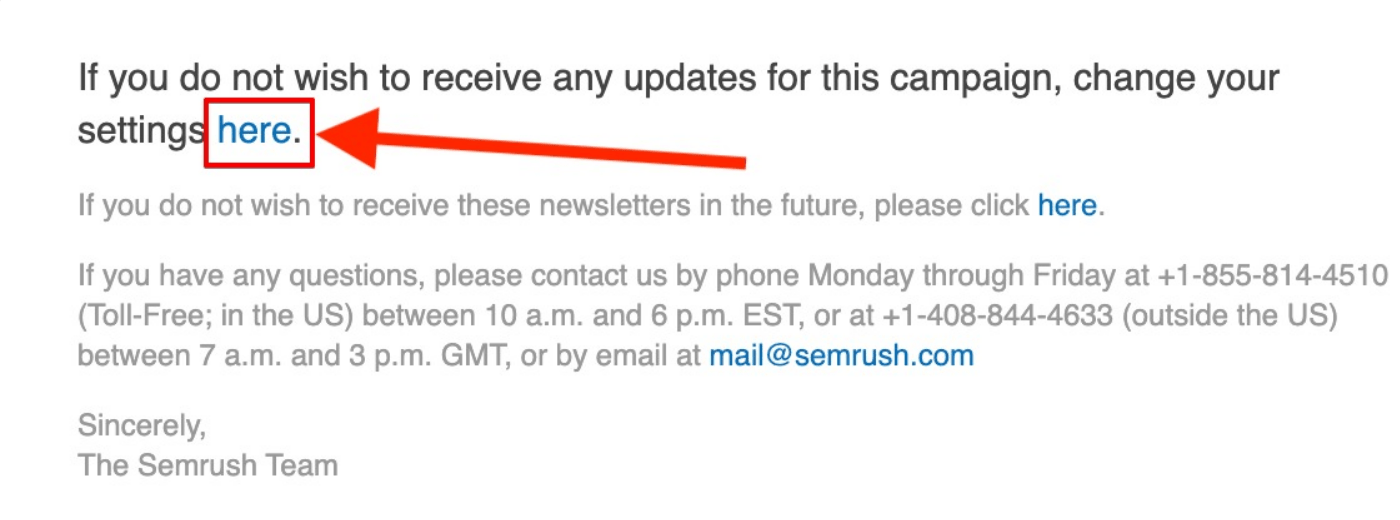
High-value/advanced customers
High-value customers have hit that cord with your product. They love your software. They are happy to continue paying for it too. They might even be ready to upgrade to a higher plan.
In short, they are your ideal clients.
They drive your growth. They refer you to others. They provide insights that help you improve the product.
This type of customer segment is perfect for value-based pricing, upselling, and upgrading.
Inactive users
There is a common misconception about inactive users.
It’s true that some of those people have lost interest in your product. But there may be others who just didn’t understand its value well enough to continue using it. Not to mention those who simply forgot about it.
Here are some ways to identify them:
- Users who haven’t used a core feature of your product
- Users who haven’t engaged with the product for a particular period
- Users who do not open emails from you anymore.
Here is an example of a reactivation email targeting users in this segment:
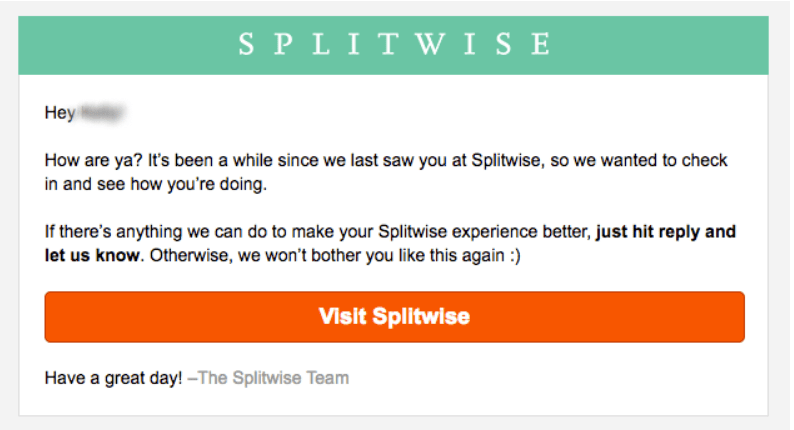
Splitwise simply re-enforces their presence with this email and empowers the user to get in touch with them. This works well for both forgetful users and those who may be stuck with using the product.
User by persona
Did you know that there is an empty chair in every Amazon executive meeting? That chair symbolizes the customer who is not in the room.
Jeff Bezos uses it to remind his executive team about the importance of the customer overall, but the strategy tells one more thing: you need to know the customers you don’t see.
You need to know their persona.
Persona segments are the backbone of so many marketing initiatives. Understanding your customers’ job titles, company size, pain points, and more helps you deliver better communications, upselling campaigns, etc.
Accounts by value
This segment is all about understanding which customers drive your revenue and which ones do not.
Because when you can tell high maximum recurring revenue (MRR) accounts from the rest, you can understand what makes them tick. And when you do that, you can communicate and market to people like them so much better.
But there’s more: you can also boost the revenue in a low MRR segment or reduce your churn rates.
Satsfied/dissatisfied users
Last but not least, you could split the user base by customer satisfaction levels. Use a net promoter score (NPS) survey to identify promoters and detractors among your customers.
Promoters offer an incredible opportunity to help promote and gain social proof for your SaaS.
On the other hand, detractors can help reveal what went wrong and how you could further improve the product.
Here’s an example of a simple NPS survey. Based on this single question alone, you can find out how many satisfied customers you have and how many might be considering churning.
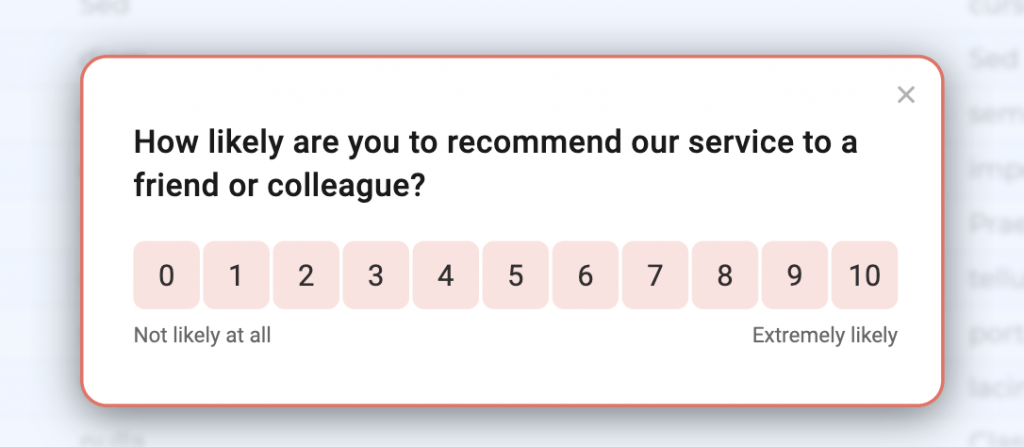
And that’s it
You now know what user segmentation is and why you need to use it. We’ve also covered some basics of segmentation strategy, along with examples.
What’s left to do now is to go and start evaluating your user base against various characteristics and build powerful user segments.
Good luck!
Don’t miss out on new articles. Subscribe to our newsletter and get your monthly dose of SaaS email marketing insights.





